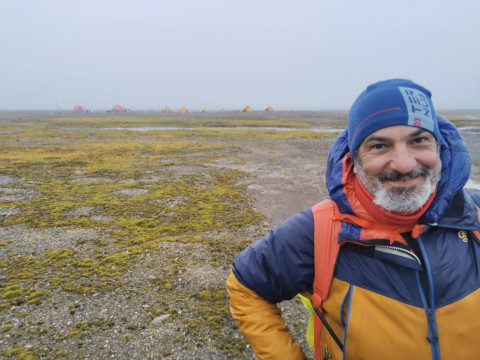Javier Méndez, ICMM-CSIC, is back from the Antarctica: "The scheduled objectives have been achieved"

Javier Méndez, a researcher from the Materials Science Institute of Madrid, is now home after spending several weeks in the South Pole as a scientist for the Spanish Antarctic Campaign 2023-24, which ventured into Antarctica to study microbial biogeography and its relationship with climate change. Méndez traveled as part of the MICROAIRPOLAR-2 project, led by the Autonomous University of Madrid (UAM) and involving other organizations such as AEMET, the Spanish National Research Council (CSIC), or the Complutense University of Madrid.
"The campaign has been a success," Méndez recounts satisfactorily from Madrid. He traveled with Cristina Casero, Ana Justel, and Antonio Quesada, all from UAM, and has been broadcasting his journey through the social media channels of ICMM-CSIC, where he has shared images, videos, scientific explanations, and Antarctic curiosities. They spent three weeks in Antarctica, two of which were on the Byers Peninsula, Livingston Island, and another aboard the Hespérides, the Spanish oceanographic vessel. During this time, "all scheduled objectives have been achieved despite the reduction in days due to inclement weather or delays in transfers," celebrates the researcher.
The goal of MICROAIRPOLAR-2 was to discover how airborne microorganisms connect distant ecosystems, playing a vital role in our global climate and ecological systems, as explained by the Autonomous University. To achieve this, they chose the Byers Peninsula as the base for their research due to its virtually ice-free nature and its designation as the "cradle of Antarctic diversity."
"This ambitious project aims to unveil how airborne microorganisms, a vast diversity of microorganisms present in the atmosphere, play a crucial role in ecosystem connectivity, even in the extreme conditions of Antarctica," indicates the UAM, explaining that the importance of studying these organisms "lies in their ability to travel long distances, influencing disciplines as varied as epidemiology, microbial ecology, the study of invasive species, meteorology, and climatology."
To understand this, air samples need to be collected, for which collectors are used: "A kind of aluminum tube through which air is passed, containing vaseline in the center to collect microorganisms," Méndez explained last year, just before embarking on his first Antarctic adventure. Upon returning from his second expedition, he indicates that more than 130 samples have been collected with an average duration of 6 hours, reaching a value of over 50,000 m3 of filtered air.
"Samples have been obtained by air filtration using collectors designed and optimized by ourselves, using cyclonic filtration equipment (Coriolis)," the researcher lists, continuing to highlight all that has been achieved in these weeks: "rainwater samples have also been collected, measurements of raindrop intensity, velocity, and size distribution have been obtained, meteorological data (pressure, temperature, humidity, wind parameters) have been collected at various locations, photos of plots of land under periodic observation have been taken..."
The work does not end there: starting in May, the collected samples will be transported aboard the Hespérides' refrigerators. It will then be when the project researchers begin to see if the results are favorable and if the initial hypotheses are valid. "We want to thank all the support personnel: mountain guides, UTM technicians, AEMET meteorologists, base personnel, military crew on Hespérides, and the polar committee for all the support and invaluable assistance provided," concludes Méndez.
Instituto de Ciencia de Materiales de Madrid (ICMM)
Sor Juana Ines de la Cruz, 3
Cantoblanco, 28049
Madrid, España
Telephone: (+34) 91 334 90 00
Email: @email
Communication Office: @email

Acknowledge the Severo Ochoa Centres of Excellence program through Grant CEX2024-001445-S/ financiado por MICIU/AEI / 10.13039/501100011033

Contacto | Accesibilidad | Aviso legal | Política de Cookies | Protección de datos